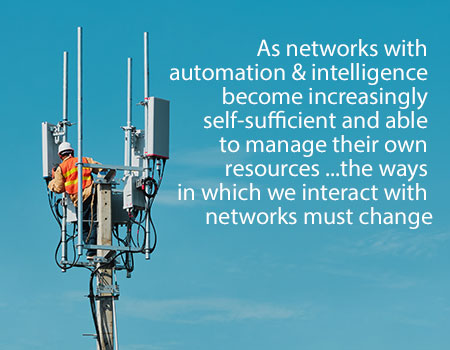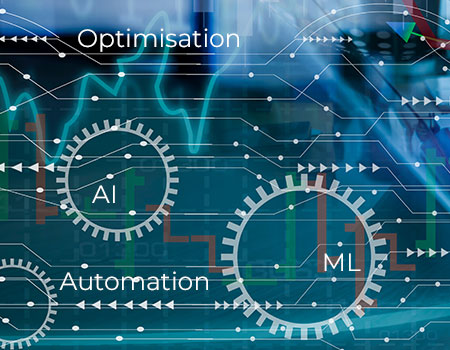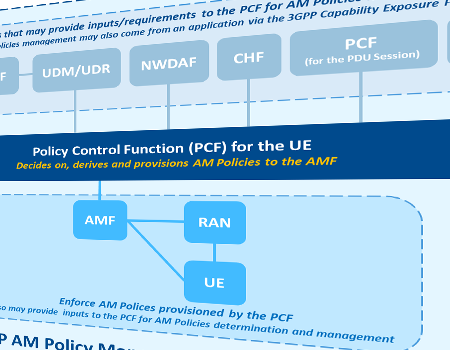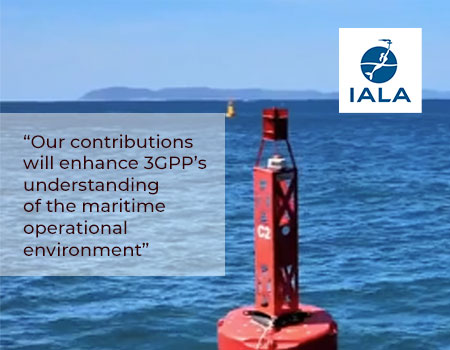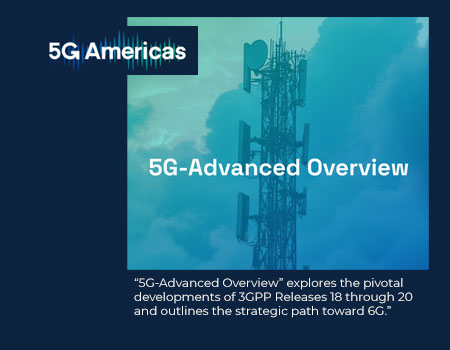By Andy Bennett, 3GPP WG SA2 Chair
First published June 2025, in Highlights Issue 10
3GPP, and WG SA2, is at a critical point, planning what will be done in the next two years in the continuation of 5G Advanced development and the start of work on 6G. For the first time in ten years SA2 will face the challenge of enhancing the architecture of one generation while developing the architecture of a new one.
SA2 is the Working Group responsible for the overall System Architecture of the Core Network part of the 3GPP system. The group defines the functionality of Network Functions (NF’s) and how they interact with other NF’s. Each release of the specifications brings new functionality and services, requiring updates to existing NF’s, or new NF’s, and new or updated interactions between them.
Relationships with other groups
3GPP’s waterfall model of specification development involves three stages: Stage 1 (service requirements), Stage 2 (architecture) and Stage 3 (protocols). For the Core Network there is one Stage 1 group, SA1, that provides requirements that define what the system does, but not how this is achieved.
The ‘how’ is the responsibility of the 3GPP Stage 2 and Stage 3 groups. The 3GPP Stage 2 groups (SA2, SA3, SA4, SA5, SA6) work on different aspects of the architecture required to support the Stage 1 requirements. The 3GPP Stage 3 groups (CT1, CT3, CT4, CT6) take the Stage 2 architecture and define the protocols required to support this architecture.
That is the simple view of how 3GPP works. In practice there are exceptions to the above. For example, CT1 specifies some Stage 2, and SA6, SA3, SA4 also have Stage 3 responsibilities). In addition, the differences between Stage 1, Stage 2 and Stage 3 can sometimes be uncertain, and of course alignments between the specifications owned by different groups are needed.
For these reasons there is a need for frequent communication between the working groups and with the parent bodies (TSG SA and TSG CT).
Release 19 - Maintenance
The Release 19 Stage 2 freeze milestone was in December 2024. Beyond that point new Stage 2 functional changes by SA2 were only permitted with the approval of SA Plenary, and some work items continued limited new work until March 2025. In addition, a decision was made in December to do some normative work on Ambient power-enabled Internet of Things in Release 19. This work will complete in June 2025.
Since December 2024 SA2’s focus has shifted to Release 19 maintenance work (correction of the specifications, alignment between specifications) and preparation for Release 20.
Rel-19 SA2 work items: There is always a broad range of work carried out by SA2 and the work items listed below shows that Release 19 is no exception.
Work Items
| Acronym | Title |
| EnergySys | Energy Efficiency and Energy Saving |
| AIML_CN | Core Network Enhanced Support for Artificial Intelligence (AI)/Machine Learning (ML) |
| 5GSAT_Ph3-ARC | Integration of satellite components in the 5G architecture Phase III |
| XRM_Ph2 | Extended Reality and Media service (XRM) Phase 2 |
| UPEAS_Ph2 | UPF enhancement for Exposure And SBA Phase 2 |
| eEDGE_5GC_Ph3 | Enhancement of support for Edge Computing in 5G Core network - Phase 3 |
| MASSS | Multi-Access (ATSSS_Ph4) |
| NG_RTC_Ph2 | System architecture for Next Generation Real time Communication services Phase 2 |
| UAS_Ph3 | UAS, UAV and UAM Phase 3 |
| 5G_Femto | System aspects of 5G NR Femto |
| 5G_ProSe_Ph3 | Proximity-based Services in 5GS Phase 3 |
| VMR_Ph2 | Vehicle Mounted Relays Phase 2 |
| UIA_ARC | Identifying non-3GPP Devices Connecting behind a UE or 5G-RG |
| MPS4msg | MPS for IMS Messaging and SMS services |
| AmbientIoT-ARC | Architecture support of Ambient power-enabled Internet of Things |
| TEI19_PRUE | PRU Usage Extension supported by Core Network |
TEI19 / Mini-WIDs
| Acronym | Title |
| TEI19_OBGAD | On-demand broadcast of GNSS assistance data |
| TEI19_MINPA | Stage 2 of Minimize the Number of Policy Associations |
| TEI19_SLUPiR | Spending Limits for UE Policies in Roaming scenario |
| TEI19_IP_SP_EXP | Enhancing Parameter Provisioning with static UE IP address and UP security policy |
| TEI19_MLR4RTR | Multiple Location Procedure for Emergency LCS Routing |
| TEI19_HSBO | Roaming traffic offloading via session breakout in HPLMN |
| TEI19_DLPMR | Deferred 5GC-MT-LR Procedure for Periodic Location Events based NRPPa Periodic Measurement Reports |
| TEI19_NetShare | Indirect Network Sharing |
| TEI19_RVAS | Architecture support of roaming value-added services |
| TEI19_ProSe_NPN | ProSe support in NPN |
| TEI19_QME | QoS monitoring enhancement |
| TEI19_TIME_SUB_EPS | Subscription control for reference time distribution in EPS |
| TEI19_VLANSUB | Providing per-subscriber VLAN instructions from UDM and DN-AAA |
| TEI19_NFsel_by_tPLMN | NF discovery and selection by target PLMN |
| TEI19_SliceSel | Network Controlled Network Slice Selection |
Note: TEI19 stands for (Small) Technical Enhancements and Improvements for Rel-19.
Release 20 – A question of time
For recent releases SA2 has planned based on a capacity of 36 Time Units (TU’s) per working group meeting. This requires three WG Streams to run in parallel for most of the first three days of each meeting. After day three (Wednesday) the meeting works only on revisions of input documents opened in the first three days. These revision sessions are not included in the capacity calculation.

All work for the new release and all maintenance work for previous releases must be planned within the 36 TU’s per meeting.
The overall capacity available during a release is therefore the number of meetings in the release timeframe multiplied by the capacity per meeting. This is split between new release work, maintenance work, and a buffer.
Between March 2025 (start of Release 20 work in SA2) and September 2026 (Stage 2 freeze for Release 20) there are 9 meetings of SA2 planned and the split of TU’s is shown below.
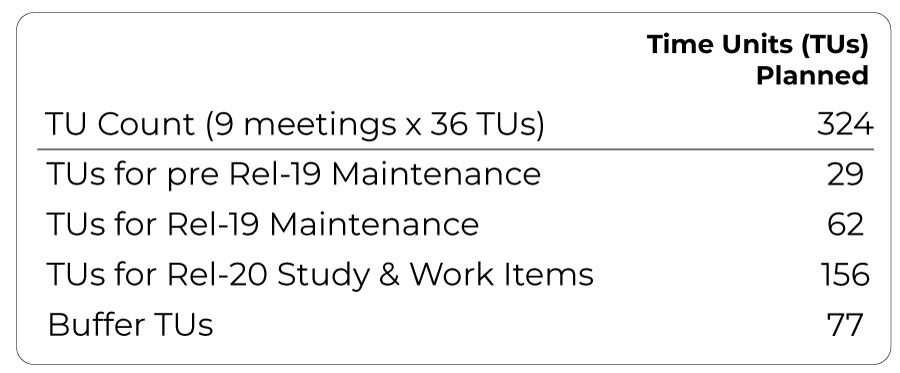
Determining what comprises the new release work is a joint effort between TSG SA Plenary and WG SA2. The SA Plenary discusses potential work areas and decides on a list of them, to go forward. SA2 is then asked to draft, discuss and agree Study Item or Work Item Descriptions (SID’s or WID’s) that contain a list of Work Tasks that are required in each case, and an estimate of the TU’s required for the work.
These SID’s and WID’s are discussed by SA Plenary and approved, or not. Even if SA Plenary approve a SID or WID it might be down-scoped. At the end of the SA Plenary meeting that determines the overall release content (June 2025 for Release 20) there will be a set of SA2 SIDs and WIDs that fit within the TU budget.
Rel-20 5GA Stage 2 SID planning
For Release 20 SA Plenary decided on a list of 5G Advanced topics in December 2024 and sent this list to SA2:
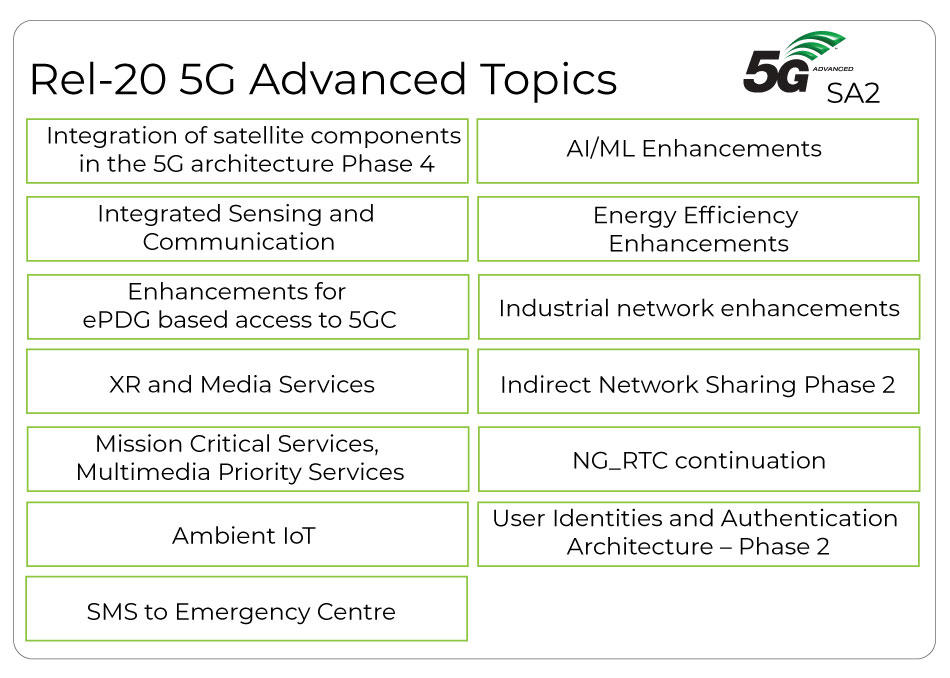
WG SA2 has used a variety of means (face to face sessions, drafting sessions, conference calls and moderated discussions via email or the New Working Methods tool (NWM) to draft, discuss and agree SID’s and WID’s in the first half of 2025. Four SID’s were agreed by SA2 in February and approved by SA Plenary in March, and technical work started in the SA2 meetings in April and May. SA2 will discuss SID’s and WID’s related to the other topics in May, and any agreed will be sent to the June SA Plenary for discussion.
A difference for Release 20 compared to recent releases is that there will be two categories of new work: 5G Advanced study and normative work, and 6G study work. The final content for 5G Advanced will therefore be dependent on how many TU’s are allocated for 5G Advanced and how many for 6G.
This division of TU’s is yet to be determined.
Rel-20 SA2 6G SID - what we know so far
A workshop attached to the TSG meetings in March 2025 gave a chance for companies to share their ideas and priorities for 6G, across RAN and SA. Following the workshop SA2 invited companies to submit their priority work areas for the Working Group, include technical descriptions of Work Tasks that would be required (at the level of detail that would be needed for inclusion in a 6G SID).
During the April 2025 SA2 meeting intensive discussion of a summary of these inputs resulted in a document that has now been used as the basis for starting a moderated discussion ahead of the SA2 meeting in May. Analysis of the company inputs to this moderated discussion will lead to at least one draft 6G SID being submitted to the May 2025 WG SA2 meeting. During that meeting SA2 will aim to agree a 6G SID and submit it to the TSG SA Plenary meeting in June.
The following potential work areas have been identified for further discussion in the May 2025 WG SA2 meeting, in Fukuoka:
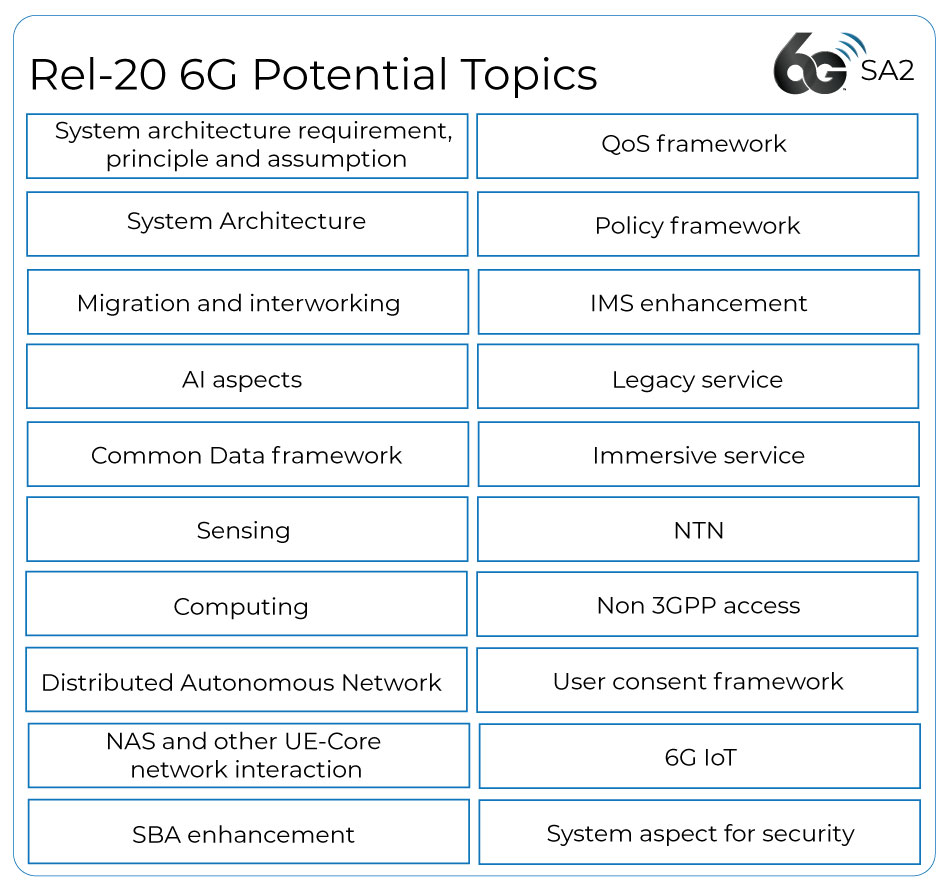
Once the 6G SID is approved by SA Plenary the technical work can start. The TU budget available for this will depend on the split between 5G Advanced and 6G as mentioned above. Because only study work will be carried out in the Release 20 timeframe, the 6G study can continue beyond the Stage 2 freeze (September 2026) and so there will be more meetings available for the work. The date for completion of the study is yet to be finalized by SA Plenary, but will be no later than March 2027. SA Plenary will review the SA2 6G SI completion date in December 2025 and make a final decision on whether finalization will be in December 2026 or March 2027.
The additional TU budget and number of meetings compared to a typical item (study work, followed by normative work) should allow time at the start of the study to discuss concepts, use cases, key issues and architectural assumptions in more detail and provide a solid platform for the later part of the study.
Release 21
The 6G work in Release 20 is critical to the development of 6G, but is only the first stage. As the SA2 6G study approaches completion, preparation work (discussion of candidate Work Item Description(s)) will start for the normative work in Release 21 so that this can start in a timely way. By the middle of 2026 SA2 is expected to be hard at work on the normative 6G specifications.
Release 21 normative 6G specification work is expected to align with the IMT-2030 submission window. To that end the timeline for Release 21 is anticipated to be finalized no later than June 2026 (the ASN.1/OpenAPI freeze is projected to be by March 2029).
In addition to the 6G normative work in Release 21 there may also be further development and enhancement of the 5G Advanced architecture, and continued maintenance of previous releases, so planning complexities similar to Release 20 can be expected.
In Summary
The planning of a 3GPP release is a complex process involving much effort within and across the Working Groups and TSGs. This is especially so, and particularly important, as we start the development of a new 3GPP generation. The above gives a brief insight into WG SA2’s part in this.
For more from WG SA2 see: www.3gpp.org/3gpp-groups


 Technology
Technology